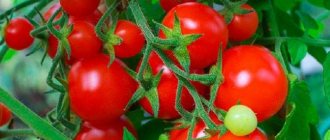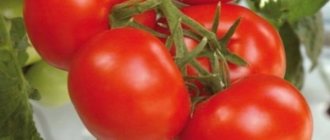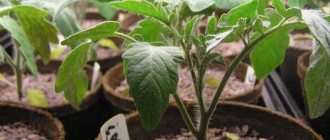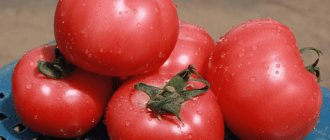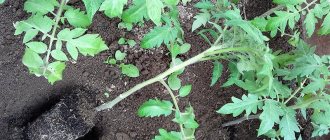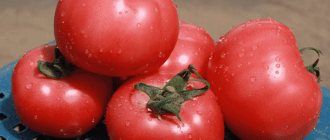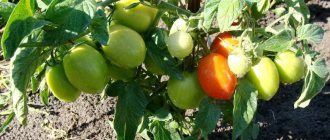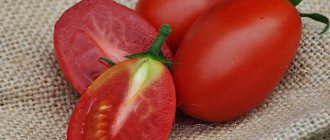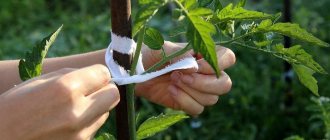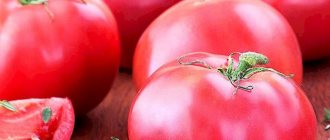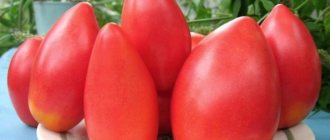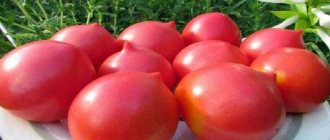Content
Tall tomatoes are well suited for greenhouse cultivation
Indeterminate - growing upward to an unlimited height, so that growth stops, the top is pinched.
Determinate – stops development after reaching a certain height.
Stepsoning is the removal of excess side shoots (they are called “stepchildren”) formed in the axils of the leaves.
Red tomatoes for cultivation in greenhouses ↑
The earliest ones are red in color. Early and mid-early varieties are often grown in greenhouses covered with polycarbonate or glass. Such varieties are better suited than others for cultivation in cool climates, for example, beyond the Urals or in the Leningrad region, since only early-ripening crops have time to ripen in a short summer. Greenhouses make it possible to lengthen the season and grow crops without ripening.
“Podmoskovny F1″ ↑
It is characterized by early ripening (95-105 days), demonstrates high fruit set. The bushes are medium-sized and have few leaves. They require formation into one shoot and pinching. The cluster is compact, consists of seven to nine fruits (about 140 g in weight). Characterized by the formation of brushes every two leaves. The tomatoes are firm and store well. The variety is resistant to fusarium, cladosporiosis and TMV (tobacco mosaic virus).
“Malvasia F1″, Semko-Junior company ↑
An excellent hybrid of mid-early ripening (111-115 days), medium height. The brushes are formed through three sheets, each containing five or six large and tasty tomatoes (220-250 g). Able to set fruit even at high temperatures, it is characterized by resistance to TMV, verticillium, fusarium, root-knot nematode, cladosporiosis, fusarium rot and brown spot. The hybrid gives good yield - up to 36 kg per square meter. meters, subject to high-quality fertilizer. Requires a garter.
A fruitful and tasty vegetable
“Extremal”, agricultural company “Biotechnika” ↑
The company has a series of vegetables adapted for growing in cold regions. Suitable for greenhouses, the fruits ripen 105-111 days after seed germination. Plants can develop and bear fruit even in areas of risky farming, and are characterized by high resistance to major diseases. The bushes grow up to 1.6 m and have few leaves. Six to seven fruits are formed on each cluster (weight up to 250 g). Plants need pinching; the growth point is pinched above the fourth brush.
“Lilos F1″, Dutch agricultural company “Rijk Zwaan” (“RIYK ZWAAN”) ↑
The hybrid, ripening at 91-100 days, is reliable and high-yielding. Fruit set is high; even under stressful conditions, plants do not shed their ovaries. The stems are strong and powerful; tomatoes reach 180 g, they are tasty, store well, and do not crack. Not susceptible to TMV, verticillium, cladosporiosis.
“Blagovest F1″, agricultural firm “SeDeK” ↑
Considered good for growing in a greenhouse environment. High-yielding, determinate bush (medium height). Round tomatoes (90-100 g) with good taste. Plants require moderate pinching. The hybrid is valued for its abundant fruiting, resistance to TMV and Fusarium wilt, as well as its resistance to weather surprises. Harmful ripening occurs 94-106 days after the appearance of sprouts.
The best frost-resistant varieties
Tomato seeds "Spiridonovsky"
This is one of the shortest varieties in our review of the best tomatoes - it reaches a maximum height of 45-50 cm. However, it is characterized by serious spreading, so it needs a lot of free space. It has a thick and strong stem and small leaves, colored dark green. The yield is average, but on one bush all the fruits ripen at approximately the same time. One of the main positive qualities of this variety is its excellent frost resistance - the bush will develop well even at a temperature of +7-10 degrees, it also perfectly resists almost all diseases and does not need additional feeding.
More: Top 10 best dishwashing detergents
The fruits are round, almost not ribbed, their maximum weight is about 100 grams, but you can grow a specimen weighing up to 200 and even up to 250 grams. Fully ripened fruits are bright red in color and have a rich tomato taste with pronounced sourness. When growing this variety, you should carefully monitor the soil moisture, avoiding its excessive increase, as this can ultimately lead to cracking of the fruit. Well suited for fresh consumption and canning.
Advantages:
- Does not require stepsoning;
- Withstands strong temperature changes well;
- Resists diseases and pests.
Flaws:
- You will have to monitor soil moisture very carefully.
Tomato seeds "Spiridonovsky"
Tomato seeds "Lemon Giant"
This is a rather exotic variety in terms of the appearance of the fruit. They are painted bright yellow, have a beautiful and large shape, and a pleasant taste. The bushes are tall, so they need to be tied up. The ripening period is average, the bushes can be grown both in open ground and in a greenhouse - in the first case, the fruits are somewhat smaller, but significantly more of them are formed on one plant. There are not too many leaves on the bushes. In greenhouse conditions, the height of plants can reach 2.5 meters, so they should be molded. In open soil they turn out lower, but you still can’t do without molding. With good care, the weight of one fruit can reach 900 grams.
The skin of the fruit is strong, but not too thick, very elastic - the plants are not afraid of excessive watering, the tomatoes will not crack even with a significant amount of moisture. They can be picked from the bush even when unripe: they will ripen at home, and this will not in the least affect their taste characteristics. Plants can withstand low temperatures and significant changes well. They contain approximately the same amount of carotene as carrots and a high percentage of vitamin C.
Advantages:
- Large fruits;
- With proper care, high productivity is ensured;
- Good nutritional value;
- Withstands long-term transportation;
- Plants practically do not get sick.
Flaws:
- It is required to follow the watering and feeding regime;
- Soil fertility must also be acceptable to ensure high yields.
Tomato seeds "Lemon Giant"
Tomato seeds Snegirek
This variety is distinguished by its insignificant height - the bushes grow to a maximum of 40 cm. The fruits are red in color and round in shape with a maximum weight of 200 grams at the first level, and up to 180 grams at subsequent levels. No pinning required. It develops at temperatures from 0 degrees, even in these conditions the yield is quite high, especially with good sunlight. The crop does not develop top and root rot and is perfect for growing on a balcony, in a greenhouse and in open ground.
Seeds can be planted even in soil unprotected from frost - the main thing is that it is well fertilized. For this variety, it is advisable to fertilize the soil with humus, cow or horse manure in the fall. When growing seedlings at home, after the appearance of two leaves, the plant needs to be pruned; during plant growth, it is necessary to additionally feed it with products containing potassium and phosphorus.
Advantages:
- Ideally withstand low temperatures;
- Good yield;
- Minimum leaves.
Flaws:
- Not detected.
Tomato seeds Snegirek
Pink varieties of tomatoes for greenhouse conditions ↑
Tomatoes with pink colored fruits are popular among culture lovers not only for the beautiful color of the skin and pulp, but also for their special taste: sweeter and more delicate. They are a little more difficult to grow than others, their yield is slightly lower.
The bushes are low (up to 44-50 cm), and the fruits are unexpectedly large (up to 250 g). From germination to the start of ripening of the first tomatoes, 100-111 days pass. Plants form three to five clusters with dense, fleshy fruits that practically do not crack and ripen well. The stepsons are removed up to the first brush. “Pani Yana” is considered a very productive variety, especially considering the height of the plants.
“Pink Spam”, Semko-Junior company ↑
It is an improved version of the famous “Bull's Heart”. The bushes are determinate, tall. Brushes are formed every three leaves. The first harvest can be harvested 95 days after the first germination of seeds. Fruits weigh on average 150-200 g, but the first tomatoes can reach 1000 g! “Pink Spam” is a super high-yielding hybrid that blooms and bears fruit for a long time. From sq. meter you can get 20 kg of delicious and well-stored fruits. The hybrid demonstrates resistance to viral diseases and many fungal diseases, but, unfortunately, has poor resistance to late blight, and therefore requires preventive spraying with copper-containing preparations such as “Ridomil”. In addition to the pink-fruited variety, you can also plant “Orange Spam”, which produces bright, orange-yellow fruits.
Description and characteristics of the variety
The hybrid was bred (Moscow), entered into the register in 2010. Recommended for regions:
- Northern,
- Northwest,
- Central,
- Volgo-Vyatsky,
- Central Black Earth Region,
- North Caucasus,
- Middle Volga region.
The hybrid is very early ripening, so it is better to plant it under film covers - this will allow you to get the earliest possible harvest. The first fruits are harvested on the 88th day after full germination.
The bushes are convenient for growing in tunnels - they are not tall and stop growing on their own.
The height of the bush is no more than 50 cm. The tomatoes are quite large, the average weight is 130 g, the taste is excellent. The color is red, the shape is heart-shaped. The flesh is firm, the skin is smooth.
Yellow and orange varieties of tomatoes for greenhouse cultivation ↑
Yellow-fruited tomatoes are distinguished by their appetizing color, contain an increased amount of vitamins, and are also particularly sweet.
“Honey Saved” ↑
A popular mid-season variety from breeders from Novosibirsk, distinguished by large tomatoes with a honey-yellow color and weighing up to 600 g. The pulp of the fruit is sweet and has practically no sourness. The bushes grow up to 120-160 cm, they are formed into one or two shoots. From one plant, provided good fertilizer is used, four to five kilograms of tomatoes are harvested.
“Orange miracle”, agricultural company “Siberian Garden” ↑
A universal mid-season variety that produces multi-chambered fleshy fruits of bright colors and a sweetish taste. The cluster usually bears up to five fruits (weighing up to 400 g) with soft skin. Bushes of indeterminate type. It is recommended to grow plants in two stems, pinched and tied.
“Yantarny”, agricultural company “SeDeK” ↑
Early ripening, giving the first harvest on 85-100 days. The bushes are determinate, low (up to 46-50 cm), standard type, they do not require pinching. The fruits are dense, 4-6 cm in diameter (weight 50-60 g). The brushes are laid through two leaves. The “Yantarny” variety is resistant to late blight and macrosporosis and tolerates slight cold snaps well. The harvest ripens smoothly; four to six kg of tomatoes are harvested per square meter.
“Amana Orange”, from private collectors (Gusev family, Redko V.V.)
A rare but very tasty variety, bred in the USA. The plants are tall (up to 2 m), the amount of foliage is average. The fruits are round in shape, fleshy, delicious and large (300-500 g, sometimes up to 700 g). Tomatoes do not crack and store well.
Variety “Amana Orange”
Early ripe tomatoes
Tomato seeds "Pervoklaska"
This variety is considered one of the most versatile, and fruit ripening occurs approximately 90-105 days after sprouting. It is perfect for open spaces, since the maximum height of the bush does not exceed 100 cm; it needs tying, but this is not necessary, since the fruits ripen well on the ground surface. The bush should be formed into three stems, as this ensures maximum yield. From one bush you can collect about 6 kg, and the fruits lie well and withstand transportation. In addition, this type of tomatoes will feel excellent both in open ground and in a greenhouse. The first stalk is formed approximately on the 6-7th leaf.
The average weight of the fruit is about 250-300 grams. The ribbing is low, the shape is flat-round, painted bright pink. Tomatoes of this variety have thin and slightly transparent skin, slightly translucent. The taste is pronounced tomato. Well suited for direct consumption, canning, preparing ketchups, juices, pastes and other tomato products. In terms of chemical composition, this variety has many vitamins, sugars, and lycopene, which will support human immunity.
More: Morphy Richards Homebake 502001 bread maker - full review: prices, specifications, reviews
Advantages:
- High germination rates;
- Pleasant to the taste;
- Compliance with the labels on the packaging and real indicators.
Flaws:
- The lower leaves are quite large, which is why ripening may slow down by one to two weeks.
Tomato seeds "Pervoklaska"
Tomato seeds "Red Rooster"
Perfectly suited for most climatic conditions of our country, it will feel good both when grown indoors and in open ground. This variety ripens earlier than all others - for this it only needs about 85 days under optimal weather conditions. If the weather is a little cooler, then this period may be delayed by about 10-15 days. When seedlings are planted in open ground at the age of approximately 60-65 days, this allows the first fruits to be harvested after 30-35 days. The maximum height of the bush is 80 cm, so it does not require garter. In addition, it does not need tying. The best yield is ensured if there are no more than three stems on the bush.
The fruits are quite large - their average weight is about 250-400 grams; if you care for the plants well enough, you can achieve heavier tomatoes. The color is bright red, there is slight ribbing in the area of the stalk. The taste is sweet, there is a slight sourness. Tomatoes are universal - they can be eaten fresh, pickled, pickled, made into juices, pastes, and so on. It tolerates transportation quite well.
Advantages:
- The variety is unpretentious to weather conditions;
- Large fruits;
- The harvest is large, about 5 kg of fruit can be collected from one bush.
Flaws:
- A hybrid variety, you won’t be able to get the seeds yourself.
Tomato seeds "Red Rooster"
Tomato seeds “My love F1”
The height of this variety is about 50-80 cm, in greenhouse conditions and in the south of the country it can grow up to 120 cm. The average fruit ripening period is about 90-100 days, well suited for both greenhouses and open ground. This variety does not have very many leaves, the fruits do not become cracked during ripening, and the plants are well resistant to diseases and pests, including aphids. The immunity of this variety is one of the highest among all the best tomatoes of 2021 presented in our review. The color of tomatoes is red or bright red, they are round in shape, slightly elongated. The pulp is sugary, the taste is typical tomato, slightly sweet.
Weighing approximately 150-200 grams, all fruits are the same size, which can significantly increase their commercial value. There are four seed chambers, dry matter content is no more than 5%. Tomatoes withstand transportation remarkably well and can be stored for a long time in a cool place. The fruits look ideal as canned products, but they are also well suited for fresh consumption. They contain a significant amount of vitamins and sugars, making them very beneficial for health.
Advantages:
- High germination rate – can reach about 97%;
- Great taste;
- Fast maturation.
Flaws:
- In a strong wind, despite their short height, they can either bend significantly or even break.
Tomato seeds “My love F1”
Miniature tomatoes for the greenhouse ↑
Small red, yellow and even black cherry tomatoes have a sweet taste, are loved by many, but especially children, so in every greenhouse you can find a place for a couple of bushes.
“Konori F1, Japanese agricultural company “Kitano Seeds” (“Kitano”) ↑
Good early maturing hybrid (90 days). The bushes are well-leaved. Six to eight sweet tomatoes (15-20 g) are formed on the bunches. Maturation is friendly. “Konori F1” is resistant to Verticillium wilt, bacterial spot and fusarium.
Read also: Good varieties of winter garlic
Cherry “Conori F1”
“Golden bead F1″, breeding and seed company “Ilyinichna” ↑
An excellent hybrid with small cherry-shaped fruits (approx. 15 g). According to the type of growth, it belongs to indeterminate plants. The number of leaves on the bush is average. The hybrid is early ripening, characterized by abundant fruit set. Twelve to fifteen tomatoes with a diameter of 2.5 cm are formed on each brush. The shapes and sizes of the fruits are the same, they are dense, sweet and tasty. “Bead” is resistant to Fusarium wilt, cladosporiosis and TMV. Cherries are good for fresh consumption.
The bunch looks like a grape
“Dessert”, Manul company ↑
Early ripening varietal cherry tomatoes (94-100 days). The bushes are indeterminate. Inflorescences are formed every three leaves, starting above the ninth. From fifteen to thirty two-chambered tomatoes (about 20 g) are tied to a brush. It’s not for nothing that “dessert” has such a name - tomatoes are very sweet. Productivity reaches six to eight kg per square meter. meters. Plants are led into one stem, tied as necessary.
Features of cultivation
Start sowing in late March - early April. In the southern regions, this hybrid can be sown directly into a greenhouse or greenhouse. To prevent blackleg, late blight, spotting and other fungal diseases, disinfect the soil and seeds. Treat the garden bed with a fungicide, such as Bordeaux mixture. In the greenhouse, also spray the walls, doors, ceiling, trellises, garters, that is, all surfaces with the solution.
To grow seedlings on a windowsill, warm the soil to 100 °C or pour boiling water over it. Wash the seeds in a solution of potassium permanganate. Sow to a depth of 1 cm. At a temperature of about +25 °C, tomatoes will sprout in 5–7 days.
Pink Spam is distinguished by its great growth vigor, which will be evident from a very early age. Therefore, when the first true leaf appears, plant the plants in larger cups - 500 ml or make two transplants: first in 200 ml, and when the tomatoes become cramped in such a container - in 500 ml.
Otherwise, seedling care is standard, consisting of watering, fertilizing and hardening. Plant in open ground when morning frosts stop, in a greenhouse - 2 weeks earlier. Planting pattern - 70x40 cm. Form bushes into 1-2 stems, be sure to tie each one up.
The manufacturer recommends normalizing the number of fruits. If you leave 4–6 of the largest and most beautiful ovaries in the bunch and remove the rest, then the tomatoes will grow even and large. This is especially true when growing for sale, when the presentation of the fruit is important.
Video: rationing of tomatoes, which ovaries need to be removed
To prevent fungal diseases:
- A week after planting, spray the bushes and the ground under them with a fungicide solution (Skora, Ridomil, HOMa, etc.).
- During fruit growth and ripening, chemistry is contraindicated. During this period, spray with Fitosporin solution and add it to irrigation water once a week.
- Mulch the ground with straw or other dry and breathable material.
- Do not compact the tomato plantings; regularly pick off the shoots. Excess shoots thicken the bushes and interfere with ventilation and lighting.
- Increase the immunity of tomatoes with the help of growth stimulants: Novosil, Epin, Energen.
Video: prevention of tomato diseases in a greenhouse
Pink spam, according to the authors of the hybrid, has an increased fruit set, however, when grown in open ground, in conditions of drought, heat or, conversely, prolonged coolness, the flowers may crumble. During mass flowering, it would be useful to use the preparation Ovary or Bud. Of course, for abundant fruiting, plants need regular watering and good fertilizing. Use special fertilizers for tomatoes; they contain a whole range of nutrients in the correct ratio.
Harvest as it ripens. Due to the unusual color, light red with a pink tint, some gardeners have difficulty determining ripeness. Compared to ordinary tomatoes, it seems to them that Pink Spam is not yet ripe. As its fruits ripen, they actually darken, the flesh turns red and shines through the thin skin. But overripe tomatoes are no longer suitable for food; they are watery, tasteless, and the skin bursts. At commercial ripeness, the Pink Spam tomato has the color of an unripe red tomato; when pressed with your fingers, the walls are dented, but remain elastic, there is no greenery on the cut, the flesh is dense.
Tomato varieties with unusual colors for greenhouses ↑
For those who like to grow original varieties, we recommend:
“Black Moor”, agricultural firms “Seeds of Altai”, “Search” and others. ↑
Plants are semi-determinate type, bushes develop up to 1-1.2 m. The ripening of the first tomatoes begins on day 115 (mid-early). The clusters are laid through two or three leaves, each bearing up to eighteen fruits. The tomatoes have an interesting dark color, are distinguished by their juiciness and sweetness, the average weight of cream is 40 g. The variety is in collections.
Variety “Black Moor”
“Michael Pollan”, from the private estate of the Gusev family ↑
An unusual variety for greenhouses. The plants have a complex raceme, which bears a huge number of fruits. The yield is extremely high. Bushes of indeterminate type. The ripening of the first fruits begins 91-93 days after seed germination. Tomatoes of this variety are widely used in American restaurants.
Variety “Michael Pollan”
Reasons for the popularity of seeds from Semko
Experienced gardeners know that in order to obtain good seedlings, and, therefore, a bountiful harvest, a whole range of nuances should be taken into account: sowing dates, placement of vegetable, flower, fruit crops and more. But the key factor determining the success of this event is the acquisition of seeds.
As the planting season approaches, almost all land owners go to stores in order to stock up on “embryos” of future plants. And everyone is guided by their own tastes, interests, rules. Often the attractive name of the bag serves as the decisive argument, which often leads to disappointment in the future. In order not to encounter a similar problem in all the diversity of agricultural producers and brands, and not to make unnecessary expenses on the purchase of low-quality goods, you should carefully approach the choice of seed material.
Differences between a variety and a hybrid
The medieval classifier of the plant world, Carl Linnaeus, said that ignorance of the name leads to a misunderstanding of things. First, let’s define what a variety and a hybrid are and how they differ.
Lat. Solanum lycopersicum
A variety is bred by a breeder with characteristics passed down from generation to generation that distinguish it from plants of a similar species. Seeds and layerings of the variety are capable of reproducing their likeness in all subsequent seasons
Hybrid is a cross obtained from controlled crossing of parent varieties. The goal is to produce plants with the desired characteristics acquired from the parents. These may include early maturity, yield, disease resistance, taste, appearance, marketability, and more.
In tomatoes, the effect of heterosis (possession of parental properties) is strongly expressed, which has led to the emergence of a huge number of hybrids. But the acquired characteristics are preserved only in the first generation. The next season, having sowed seeds from hybrid fruits, the harvest will either not be seen at all, or something will grow that is unlike its ancestors.
Hybrids vs varieties
In order to fully utilize not only the area, but also the volume of closed space, it is rational to grow not early varieties of tomatoes for greenhouses, but tall greenhouse hybrids. They need to be tied to stakes, trellises, or twisted with the trunk around twine tied to the ceiling of the greenhouse. It is necessary to form a fruiting stem, remove the lower leaves (for better ventilation), break off the stepsons, and pick off excess flowers.
F1 hybrid tomatoes are most characterized by general positive qualities:
- Friendly germination
- High knotting
- Fruit evenness
- Disease resistance
- Tolerance to temperature fluctuations
- Gradual maturation
- Long (5-7 years) seed germination
A common negative property of all hybrids is the inability to preserve the varietal characteristics of the parent plants in the seeds.
The negative quality of the varieties is insufficient genetic resistance to tomato diseases.
Care
To get a good tomato harvest, you need to create optimal conditions under which this hybrid will reveal all its potential.
Light. The artist is not particularly picky about lighting. It bears fruit well and sets fruit even in relative shade. This is a rather rare quality in tomatoes, especially considering that their homeland is tropical America. However, if it is possible to create conditions for good lighting, the plant will thank the owner with increased productivity.
Temperature. Typically, protected soil tomatoes like stable heat without much temperature fluctuation. But Artist f1 tolerates temperature changes well and continues to bear fruit even when the temperature drops. Its fruits still remain aligned and attractive. This hybrid is also resistant to elevated temperatures. Summer heat does not negatively inhibit fruit formation.
Formation. Since Artist f1 is a hybrid of the generative type, its main task is not to increase the green mass, but to fill the fruit. In order for a variety to maximize its abilities, the gardener must help it with this. First of all, you need to form a plant with 1, maximum 2 stems.
Constantly remove all shoots and harvest the ripe crop. Avoid dense plantings; the norm is no more than 4 bushes per 1 m2.
Protection. Despite its natural immunity, preventive measures to protect plants should not be neglected. After all, preventing a disease means not only saving on means of combating the disease, but also getting a good harvest, which means a good income for farmers or additional products for the summer resident.
Care. Systematic watering, loosening the soil and fertilizing will also have a beneficial effect on the growth and fruiting of plants.
Follow all the recommendations, everyone can get a harvest of Artist f1 tomato fruits in quantities from 10 to 30 kg per m2, you just need to put in a little effort and desire.
Such different hybrids
Among hybrid tomatoes, determinants (deets) and indeterminates (indets) are distinguished. The difference between the latter and the former is the strength of growth. For indets, it is limited only by the duration of the gardening season and the height of the greenhouse, and without this, it would grow and grow - 15-20 m, with trusses planted every 1-3 leaves.
Determinate tomatoes are self-terminating (the growth of the main stem ends after the formation of a certain number of fruit clusters). Stepchildren formed in internodes are capable of reaching greater heights.
Semi-determinate hybrids (semi-children) have been bred: the height is decent, but the growth and number of inflorescences are limited.
Growing
For the Kemerovo variety, seedling cultivation is used. The plant's seedlings are very unpretentious and form quite quickly. Typically, the seedling stage of the Kemerovo tomato does not last more than 1.5 months (the vast majority of varieties have a seedling growth period of about 2 months).
Growing seedlings
Seeds are planted for seedlings in mid-February or early March for greenhouse cultivation or in early April for outdoor cultivation. Before planting, it is advisable to disinfect the seeds in a 0.1% solution of potassium permanganate, after which they need to be dried and soaked for a day for pre-germination.
Planting is carried out in seedling boxes or individual pots filled with ordinary garden soil or substrate. It consists of a mixture of peat and sand, taken in equal proportions. The seeds are buried by 3-5 mm.
Next, the seedlings undergo a standard procedure: they are covered with film and sent to a warm and dark place until the first shoots appear. After the first shoots appear, the seedlings are placed on the windowsill of the south window.
Watering the seedlings should be timely and combined with 2-3 fertilizing with complex fertilizers, repeated once every 2 weeks.
If planting in a common container was used, it is recommended to pick the plants into individual containers. Typically, picking is carried out after the appearance of two true leaves. After picking, the plants cannot be fed for a week.
Before planting in a greenhouse or open ground, it is necessary to carry out a hardening procedure for seedlings that lasts one week.
Landing rules
Kemerovo tomato seedlings are ready for planting in a permanent place after 40 days. Planting of seedlings in open ground is carried out in the middle or end of May. Seedlings can be planted in the greenhouse much earlier - in early or mid-April.
For planting, dig holes 15 cm deep, pour a large amount of water into them and wait until it completely disappears. In this case, the soil at the bottom of the hole acquires the consistency of liquid slurry. Plants are replanted with a clod of earth so as not to injure the root system.
Planting is done in several rows according to a pattern of 30 by 40 cm. It is not recommended to place more than 4 bushes per 1 square meter. m landings. The optimal arrangement of the bushes is in a checkerboard pattern.
Watering and fertilizing
Watering of adult plants is carried out as the soil dries. When watering, you should pour water at the very root of the plant so that it does not fall on the leaves. It is recommended to water with warm, settled water, 2-3 °C above the air temperature.
To avoid loosening after each watering, it is recommended to mulch the soil around the tomatoes with straw or freshly cut grass.
During the growing season, organic fertilizers are preferred. To do this, use ash or herbal infusions once a week. Before flowering, phosphorus-potassium fertilizers are applied once.
Pinching and tying
The Kemerovo tomato variety is very convenient in care regarding the formation of the bush, since it does not require any tying or pinching.
Formation
The bush is formed into one stem. Since the Kemerovo tomato is determinate, there is no need to pinch the top. The growth of the bush in height ends without human intervention - with the appearance of the first flower cluster, it stops on its own.
Since all determinate varieties form flowers earlier than others, the bush quickly stops its growth and begins to form new brushes, which, in fact, ensures its early ripening.
Protection from diseases and pests
The Kemerovo tomato has immunity to late blight and good resistance to other fungal diseases, but it is impossible to give a 100% guarantee that the variety is invulnerable to them. For example, almost all residents of a garden can become infected with powdery mildew.
To combat diseases, most of which are fungal diseases, standard methods are used - spraying bushes and root zones with copper-containing preparations. If characteristic symptoms of fungal diseases appear, it is necessary to spray the plants with a 1% solution of Bordeaux mixture once every two weeks.
The main pests of the variety in question are typical representatives of the animal world, specializing in nightshade crops - Colorado potato beetles, wireworms and mole crickets. Since each of them relates to insects, chemical insecticides, for example, Arrivo or Decis, will be effective.
Let's decide on the deadlines
Early ripening tomatoes are divided into early, mid and late ripening.
From the moment the seedlings are planted in the greenhouse until the first fruits are collected, the number of days required is:
- Early ripening 90 - 95
- Mid-season 100 – 110
- Late ripening from 115
In the case of sowing seeds directly into the ground, these periods are reduced by 5-10 days.
Read also: The best varieties of sweet tomatoes
Indeterminate hybrids
One of the tomato varieties
Without new products, the list of which is replenished every year through the efforts of seed companies, working in the garden is not interesting. But don’t get carried away by the tempting novelty too much. An old trusted friend, as the saying goes, is better than several new ones. Let's take a good look at some hybrids.
Typhoon F1, Hurricane F1, Semko-Sinbad F1 have long proven themselves by early ripening with a decent yield (up to 10 kg/sq. m), appetizing appearance, and excellent taste. They have the first inflorescence for fruits of up to 6-8 pieces, each weighing at least 70 g, placed behind 6-7 leaves. Next, fruit clusters are formed after 1-2 leaves. The tomatoes are round, smooth-skinned, bright red.
Samara F1 is an early ripening semi-child with cluster fruit formation. Each cluster contains 5-7 round, smooth and dense fruits weighing 80 g.
Determinate hybrids
Verlioka F1 pleases with a harvest of 5 kg per bush, shoot formation is reduced.
Tornado F1 is known for its versatility of use and suitability for low greenhouses (it stops growing when it reaches 1.5 m).
Nevsky Prospekt F1 – early ripening, cold-hardy, large-fruited. Resistant to late blight. It is not tall - only 60 cm. It reaches great heights due to the development of apical stepsons. Tomatoes without greenery around the stalk, red, flat-round, weighing on average 200 g, fleshy and dense, high sugar content.
Lamp F1 – salad purpose. Bright red without a green spot on the top, round with a spout at the tip, dense fruits under a thick skin weighing 0.2 kg each. Valued for its abundant, long-lasting fruiting, heat tolerance, disease resistance to late blight, and tobacco mosaic virus.
Large-fruited hybrids
Gondola F1 – early maturity combined with high yield. The fruits are of excellent marketability and taste, keep quality, and are transportable.
Semko-99 F1 – mid-early child. The fruits are smooth with slight ribbing, red, large (170 g each). Suitable for transportation. Productivity up to 15 kg per square meter. m.
Stresa F1 is a mid-early indete with a yield of up to 25 kg per square meter. m. Characterized by complex disease resistance. The inflorescence bears 6 fruits.
Castalia F1 - the first fruits weighing 230 g ripen in 110 days. Possibility to get from 1 sq. m of greenhouse 20 kg of fruit.
New products from the last 5 years
Rich harvest of tomatoes
Barberry F1 is famous among early-ripening cherry-shaped hybrids for the number of small (10-12 g) fruits - there are more than 100 of them on the brush. Plant height up to 2 m.
Sapporo F1 – cherry fruits, 20-25 pieces in one cluster. You can harvest with brushes - tomatoes weighing 20 g ripen at the same time. The weight of one brush reaches 0.5 kg. Cherries do not crack and are transportable. The hybrid is disease resistant.
Origami F1 – medium early, plum-shaped. The fruits are without greenery at the stalk, bright red, strong and smooth, with excellent taste. The hybrid does not crack, is resistant to blossom end rot, fusarium, tobacco mosaic virus, and nematode.
The best productive varieties
Tomato seeds "Rio Grande"
The bushes of this variety are low - reaching only 70 cm, so they do not require tying or pinching. There are not too many leaves, the fruit shape is standard. They grow in clusters of 8-12 tomatoes per plant, with a slightly oblong shape. The rafts have dense pulp and thick skin, and not too many seeds. The weight is a maximum of 150 grams, but they are often smaller and colored bright red. It tastes like classic tomatoes – with a slight sourness. Ripening occurs approximately 120-130 days after sowing. Fertility is high, can reach three months, until the onset of cold weather.
More: TOP 10 best phytolamps for seedlings and plants
The variety perfectly resists low and high temperatures, can withstand even prolonged drought, and is not sensitive to parasites and diseases. If grown over a large area, it does well in bright sun. The fruits can easily withstand even long-term transportation and are well preserved for two to three months if kept cool. They are considered universal in use; if desired, they can be dried or even dried.
Advantages:
- Strong fruits;
- The thick skin prevents damage to the crop;
- High level of endurance.
Flaws:
- The taste is a little worse compared to large-fruited varieties.
Tomato seeds "Rio Grande"
Tomato seeds "Snow Leopard"
One of the most productive and hardy varieties in terms of climatic conditions - well suited even for Siberian conditions. The yield is quite high: with proper care, you can harvest about 8-9 kg from one bush. This variety can be considered quite early - the average ripening period is about 105-110 days when grown in open ground. In terms of height, the breed is ambiguous: the bush can grow to an unlimited height, so it will need not only gartering, but also shaping. As experienced gardeners advise, it is best if it grows in two stems; moreover, it should not grow higher than 60-70 cm. This is quite convenient, since you do not have to tie it up.
This variety has quite a lot of foliage, and all such leaves are quite large; they should be removed in a timely manner, as they will take away additional moisture, nutrients, and block access to sunlight for the fruit, which will slow down ripening. The shape of the fruit is oblong, slightly flattened. The density of ripened tomatoes is medium, the skin is strong and thick, which allows them to withstand transportation. The color of the fruit is orange-red, the average weight is about 150 grams, but there are tomatoes weighing about 300 grams or even more. From one bush you can collect up to 5-6 kg.
Advantages:
- Can be grown in any conditions, including on the balcony;
- Ripens quickly;
- Resists well against any disease;
- Retains an attractive appearance for a long time;
- Handles transportation well;
- High yield.
Flaws:
- It is necessary to monitor the condition of the bushes and shape them in a timely manner.
Tomato seeds "Snow Leopard"
Tomato seeds "Asvon F1"
This is a hybrid variety that perfectly withstands temperature changes, does not get sick, and is also able to please the summer resident with a fairly rich harvest. It grows well not only in open ground, but also in a greenhouse, greenhouse or even on a balcony. The fruits will be stored in their original form for a long time and can be transported over long distances. It is distinguished not only by its high yield, but also by its early ripening. The bush is not tall and takes up little space, so one square meter can accommodate significantly more plants than another variety. There are not too many leaves, dark green in color. The fruits are formed in clusters of 5-6 pieces; about 8-9 kg of selected tomatoes can be harvested from one bush. During the fruiting period, the plants are simply strewn with fruits, and they also look very beautiful.
The shape of the tomatoes is round, slightly reminiscent of a cube, and the ribbing is almost not noticeable. The skin is shiny, dense, the fruits almost do not crack. The weight of the fruit is about 100 grams - not too large. The pulp is dense and retains its original shape for a long time. The taste is rich, has a slight sourness, tomatoes contain a large amount of vitamins and sugars, dry matter no more than 6%. The color is bright pink.
Advantages:
- Excellent taste;
- Good yield;
- Immunity to parasites and diseases;
- Fast maturation.
Flaws:
- Not detected.
Tomato seeds "Asvon F1"
The best varieties of early tomatoes for greenhouses
Tomato hybrids with index F1 are not associated with genetically modified plants. And yet, some doubters or adherents of varietal seed production prefer to harvest from ordinary tomato bushes.
Large-fruited varieties of mid-early tomatoes for greenhouses:
- Honey-sugar - the name speaks for itself. Yellow large fruits weighing 400 g. Bush height 120 cm.
- Your Honor is a high-yielding (up to 8 kg), vigorous bush (140 cm) with fruits up to 1 kg (the first ones in the lower tier).
- Love - all flowers turn into fruits weighing 1/4 kg. The height of the bush is 1.2 m.
- Bull's forehead - 100% fruit set will allow you to harvest up to 18 kg/sq.m.
- Olesya is a tall (2.5 m) salad bush, whose fruits weighing up to 300 g are distinguished by a high content of carotene.
- The mystery of nature is the combination of sugar taste in fruits with dietary properties.
- Sugar bison is a large-fruited (up to 800 g) variety of early ripening.
The tomatoes of the given varieties are not only used for fresh salad purposes, they are suitable for processing.
Not everyone can afford a polycarbonate greenhouse, making do with film shelters and constructing them from scrap material (often from window frames). This is where low-growing tomatoes come in handy:
- Gulliver is tasty, large-fruited (up to 0.8 kg 1 piece).
- Killing power – unpretentious, universal purpose, super-yielding, fruits up to 150 g.
- Bag - very tasty, fleshy, weighing up to 400 g.
- Verlioka plus - it is worth especially noting the abundance and taste.
There are a great variety of early varietal tomatoes for greenhouses, and breeders are working in this direction.
How to grow seedlings
Sowing of seeds begins in the last ten days of March. But the specific timing is influenced by the climatic features of the region.
Before planting, seeds are determined for suitability by placing them in a saline solution. To do this, dissolve 1 teaspoon of salt in a glass of water. Floated seeds are not suitable for sowing. The rest are washed well in clean water. Soaking seeds in a growth stimulant increases germination. To germinate the grains, they are placed in a damp cloth for 1-3 days.
Reference! Seeds for planting next year should not be selected from the hybrid variety yourself. This will not give any result. Purchase planting material from specialized stores.
After the first shoots appear, the seeds are planted in prepared soil. A mixture of peat and humus at a ratio of 2:1 is suitable. You can sow seeds in wooden boxes, plastic glasses, peat pots. A thin layer of drainage from small pebbles or wood shavings and soil are poured into the containers.
The soil is moistened and the sprouted grains in a damp cloth are placed in shallow (up to 2 cm) holes. After sowing, the soil is leveled from above and watered with water with the addition of growth stimulants. After which the containers are covered with film.
The containers remain in a lighted room where the air temperature is at least +23C. When shoots appear, the film is removed and complex fertilizers are applied.
Picking of seedlings is carried out after the appearance of three true leaves. If the seeds were sown in individual containers, picking is not required.
2 weeks before planting young bushes in open ground, the seedlings begin to harden off. The hardening process comes down to keeping the seedlings in the open air for a certain time: from 1-2 hours to 1 day. At night, the seedlings are removed to a room where the air temperature is no more than +13C.
Advice! Before planting tomatoes in the garden, young plants must withstand being outdoors for at least 14 hours.
